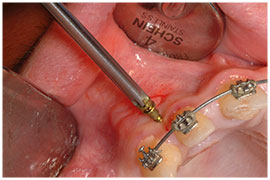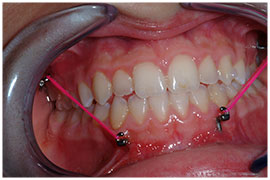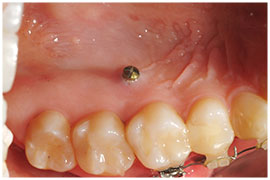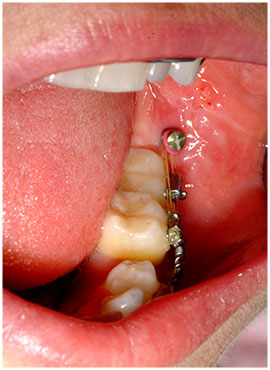
Temporary anchorage devices, or TAD's, and skeletal fixation plates are innovative, small, titanium anchors used in orthodontics to help achieve tooth movement which cannot sometimes be achieved with conventional braces. These devices allow for tooth movement to occur more efficiently and comfortably in cases where there is the need to apply greater forces or when the direction of force required is very different than that which can be provided by the teeth and/or braces alone. In the past, patients requiring greater anchorage had to rely solely on unattractive headgear or maintainers. These devices are used as an alternative to headgear use. The use of either TAD's of fixation plates is generally determined by the amount of force required and direction (vector) desired to achieve the expected outcome.
TAD's are small screw-like devices that are placed between the roots of teeth and directly into the bone which can be placed with small amount of local anesthesia and with limited surgical intervention. This simple device provides a much-needed “fixed point” to accomplish effective tooth movements. These can be placed either on the lip side of the upper and lower jaw as well as in the palate. As the name describes the device, these are only placed temporarily until the movement desired is obtained and these can be removed. Some of their advantages include:
While TAD's alone may be enough for certain patients, others require an extra boost to support tooth movement; that is, they need enhanced anchorage which the TAD might not be able to provide. For these cases, titanium skeletal fixation plates are then used. These can be prefabricated plates used specifically for dentofacial orthpaedics (i.e. Bollard Plates), or custom molded plates that can be adapted to any part of the facial skeleton depending on the need. These are generally however placed under general anesthesia. These plates are generally used for:
Removal of a TAD or plates is much easier than their placement and it usually takes just a few minutes. Tylenol® or ibuprofen is recommended to help relieve your pain after TAD or plate removal. TAD's or plates can be cleaned by brushing them while one brushes their teeth and sometimes the use of an antimicrobial mouthwash are needed.



